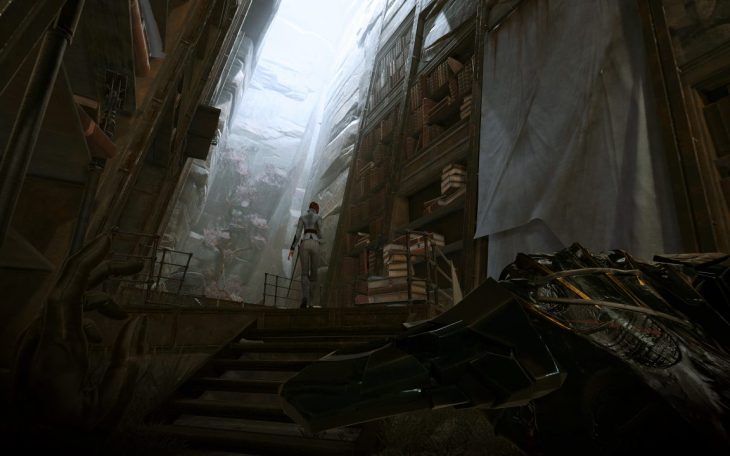When I covered Dishonored 2 last year, I called it a perfect sequel. Not because it’s a perfect game – though it’s close – but because it’s a sequel that took every aspect of the original and improved upon it. The solid foundation of the first game made it look easy, but Arkane Studios took great care to master their mechanics on the second go-around. It’s that mastery that has me feeling conflicted on the new expansion, Death of the Outsider.
Don’t get me wrong – this expansion is a highlight reel of what makes the Dishonored series great. Each of the five levels requires the same extensive knowledge of both how they’re laid out and how to use your powers to maximum advantage to succeed. The story, while a bit quick, expands on the one part of the lore fans want to know more about.

Despite this, the expansion feels lacking. Maybe it’s the short runtime or the reused environments, but Death of the Outsider feels more like an extra couple of levels than a worthy thirty dollar sidepiece. What is here is great stuff, we just need more of it.
Shortly after the events of Dishonored 2, Billie Lurk is on a mission to save her longtime mentor and series antagonist, Daud. Upon rescue, he presents Billie with a seemingly impossible task: assassinate the Outsider. Wanting to repay him for her past misdeeds, she reluctantly accepts. The Outsider, aware of her new mission, decides to visit Billie and grant her the powers of the void against her will. It’s an interesting set-up, and one you want to be fleshed out and experienced.
Instead, we’re given a rushed story – one that I completed in four and a half hours with most side content finished, though those that like to do ghost playthroughs will be closer nine or ten hours (there’s also a new game+ mode with the original Dishonored powers). It feels like Arkane had a full-length story planned, but were forced to cut half of it late into development. The essential story beats are here but don’t have much lead-up. They just happen in between missions. You’re planning the death of an all-powerful god. It shouldn’t occur as quickly as it does.

Side-content is the same as before. Contracts are clever side-missions with objectives like “capture this person without being seen” or “eliminate her in a specific way”. I always looked forward to completing these. Safes are still hard to crack, paintings are well-hidden, and good luck collecting all the gold in a mission on a stealth playthrough.
Levels are more limited than what we’re used to. There aren’t as many alternate routes for stealthy players, but Billie’s moves make up for that. Her limited powers are modified forms of the game’s usual ones, alongside a couple of new ones. Foresight allows you to stop time and explore an area thoroughly, marking enemies and items of importance. Displace is a dumbed down Blink. Semblance has you impersonating another human, letting you roam freely for a limited time. Violent players will take to Void Strike – a charge up attack that sends enemies flying. Billie can also talk to rats. These conversations aren’t beneficial; they’re more for fleshing out small pieces of lore and comedic relief.

Instead of a variety of powers, bone charms are used to instill variation. Tons of these modifiers are hidden in each mission, most of which make drastic changes to your move-set. I did miss some of the abilities I’ve become used to, like bend-time, but the charms are a decent replacement. Charm crafting also makes a return.
Most levels are reused areas from the previous games, but with small twists. This adds to the shorter game time, as you’ll already know how to get around. Fortunately, Arkane uses these assets as an opportunity to show what happened after Emily or Corvo have made their mark, with The Royal Conservatory being my favorite example. Getting through these levels stealthily requires a lot of waiting around due to lack of alternate paths. While this isn’t always the case, linearity takes over in more situations than I’d have liked. Especially considering the variety of runs the previous games have.
Death of the Outsider is just as gorgeous as the other games, with the prettier parts of Karnaca being shunned for the grimier ones this time. That’s not to say you won’t visit some grand locales, but this focus on the underbelly is a nice change for the Dishonored franchise. The games final mission is one of the high-points in the series regarding aesthetics. I don’t want to spoil it, but be sure to take your time and explore upon arrival.

Maybe I’ve been spoiled by the previous Dishonored games, but Death of the Outsider doesn’t feel like the expansion it could have been. While the locales and gameplay are all here, the story is neutered and the levels, while still big, aren’t as deep. It’s a straightforward experience – a taste of what the full games have to offer. The replayability is there for those who want it, but the initial experience, the one that a majority of players will tackle, doesn’t deliver on all fronts. It’s more of the same incredible stuff, just not quite as good as we’re used to.
This review is based on a digital review code of Dishonored: Death of the Outsider for the Xbox One, provided by Arkane Studios
Discover more from The Koalition
Subscribe to get the latest posts sent to your email.
